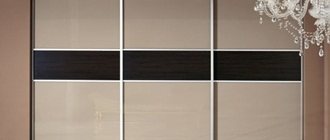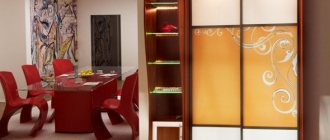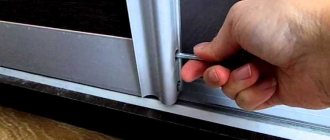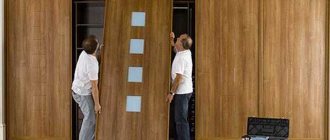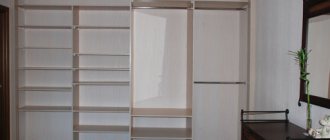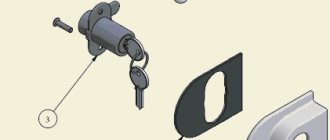0
63557
Sliding wardrobes today are one of the most popular types of furniture for residential premises. They are relevant for living rooms, bedrooms and children's rooms, entrance areas of country cottages and narrow corridors of city apartments. But maximum spaciousness, practicality, and functionality will be characteristic of such furniture only if it is equipped with sliding systems for high-quality sliding wardrobes.
Materials for making cabinet doors
Wardrobe doors differ from each other not only in the opening system used, but also in the materials used. What types of cabinet doors are there by type of material? Wooden, mirror, glass.
Wooden panels have found application in the production of hinged cabinet models. Wood is characterized by high strength and long service life. In addition to natural wood, materials based on wood boards are widely used in the production of cabinet doors - chipboard and MDF, which have gained popularity among consumers due to their affordable price and variety of claddings.
Mirror and glass facades visually increase the space of the room. Tempered glass and mirrors are most often used in cabinets with a sliding opening mechanism.
Depending on the design, there are several types of door leaves:
- solid;
- with cutouts;
- louvered;
- with glass inserts.
Basic shapes and configurations
Sliding wardrobes with sliding doors are available in configuration and fastening:
- with an overlay profile that is placed on top of the door leaves, but does not stand out visually;
- frame - do not differ in any way in appearance, but are installed on a stronger base;
- suspended - fixed on the upper roller mounts, which can be seen if you look closely at the design;
- coplanar - allow you to install door leaves with a minimal joint between them: when such doors are opened, one leaf completely overlaps the other.
With overlay profile
Framework
Hanging
Coplanar
Varieties of doors for sliding wardrobes allow you to choose the shape and size that will best contribute to their comfortable use. The most common, classic shape for a sliding wardrobe door is a flat rectangle. Its length depends on the height of the furniture, and its width on the number of doors and the size of the space that has been allocated for its location. At the same time, built-in models usually reach the ceiling, while free-standing ones may be slightly lower.
How to choose components for a wardrobe, useful tips
The remaining types of doors for a wardrobe with a compartment design, according to the format of the sliding part, are divided into curved and radius, which are also called radial, since their outlines describe some kind of semicircular, oval or other rounded curve. The first type of wardrobe door is an indirect leaf, with the shape of the bend selected individually for specific furniture. The second type may have concave or curved outlines.
Flat
Bent
Radial
Types of decor for cabinet door facades
Various design techniques are used to decorate the front part of the cabinet. Furniture manufacturers use textiles, leather, and carved elements as decoration.
In swing models, original door handles can serve as a decorative element. The mirror and glass facade of the cabinet can be decorated with designs applied by sandblasting or by partially removing the mirror layer, photo printing, or colored stained glass. The highlight of the transparent glass facade is the lighting located inside the cabinet.
Tips for choosing
When choosing ready-made furniture or ordering according to individual measurements, you need to pay attention to the sliding wardrobe system used. The following recommendations will help you avoid becoming a victim of unscrupulous manufacturers:
- During operation of the cabinet, the main load falls on the door opening mechanism, so it is worth choosing high-quality fittings. The most durable sliding systems are made of aluminum alloys.
- When choosing a wardrobe for a child's room, you need to take into account the age of the child. Since furniture for children does not need a very long service life, you can save a little on fittings, for example, instead of aluminum profiles, purchase steel ones, which are also quite reliable. Over time, the cabinet will still have to be replaced, so there is no point in spending money on expensive parts.
- When purchasing bedroom furniture, you need to make sure that it has a sliding door lock installed, which allows you to close the facades as silently as possible. This is convenient when one of the spouses is still sleeping, and the other needs to use the closet.
When choosing a wardrobe that divides a room into zones, it is worth considering that the back wall should be made of facing material.
When choosing a particular cabinet model, you must check the quality certificate. This document confirms that the furniture is made of safe materials. If they refuse to present the certificate, you should think about the feasibility of such an acquisition.
Popular sandblasted designs for wardrobes, nuances of choice
You should choose high-quality fittings, since the entire load falls on the doors
When choosing a wardrobe for a nursery, you can save on a sliding system
The bedroom closet must be equipped with a door lock
The back wall of the partition cabinet must be made of facing material
Photos of cabinet door opening systems
<
>
Which doors to choose for the closet depends on the design features of the storage system itself and the general style of the room. A well-chosen door opening mechanism and facade decor will not only ensure ease of use of the cabinet, but will also make this piece of furniture the highlight of the interior!
Classification
The modern furniture market offers several types of sliding door mechanisms for wardrobes. They differ in type of construction and materials of manufacture. The choice of the optimal option depends on the shape and dimensions of the product for which the fittings are selected.
Types of fittings for sliding wardrobes, functionality of elements
By type of design
According to this criterion, sliding mechanisms for wardrobes and wardrobes are divided into the following types:
- Roller - the system consists of upper and lower guides, which are built into the furniture body. Door facades move along these profiles on special wheels. The main load falls on the lower guide, so its installation requires special attention.
- Hanging - the doors of the structure are fixed on the top guide. When moving, the facade does not touch the floor and the lower part of the body. The disadvantage of this installation method is its relative fragility. This option is not suitable for heavy doors; the recommended weight of the door leaf is no more than 80 kg.
If you plan to make a wardrobe with your own hands using a hanging sliding system, the doors are best made of plastic, glass, plywood or chipboard.
Roller
Hanging
According to the material of manufacture
If low quality raw materials are used in furniture production, the product will not last long. In this regard, when choosing sliding elements of the system, you need to pay attention to the materials of manufacture:
- Steel - stainless alloys are used in the production of accessories for the economy segment. The material is considered relatively reliable, but has a lot of weight. If handled properly, steel profiles will last no less than more expensive options.
- Aluminum - the metal is used for the production of luxury cabinet models. Its advantage is considered to be the ideal ratio of lightness and strength. Handle profiles, guides, and door frames are made from aluminum. Another advantage of the material is the variety of colors and textures. The disadvantage is the high cost.
Advantages of sliding wardrobes with photo printing, popular images
An aluminum profile can be decorated in two ways:
- anodizing - applying paint with a chemical reaction, while the pigment penetrates deep into the metal and remains resistant to moisture and sunlight;
- PVC film - using special equipment, the part is covered with a durable laminating film, which is also wear-resistant.
Aluminum profiles and guides can be painted in any color, matte and glossy textures, wood or stone finishes are available. Matte bronze, silver or gold shades, artificial aging of the surface, and patination are popular.
Steel
Aluminum
Anodizing
PVC film
According to the shape of the door and the presence of the frame
Sliding systems for sliding wardrobes differ in the type and shape of the facade, the presence or absence of a frame:
- In the form of a separate suspension, the rollers are placed inside the guide. This ensures quiet and easy gliding.
- Systems for radius facades - profiles have curved or concave shapes, which makes it possible to install semicircular doors. The guides for such cabinets are made of aluminum, which makes the design more expensive.
- Frame - the material of the door facade is framed in a special metal frame, which can be made of stainless alloy or aluminum. Such designs are used when doors are made of fragile materials, such as glass or plastic. In this case, the frame ensures the strength of the facade. In addition, a metal element can be used to divide the door into several parts, each of which will differ in color or material (combinations of wood and glass, plastic, rattan, bamboo are popular).
- Frameless - the design is the most budget-friendly. Only one vertical profile can be attached to the facade, acting as a handle. All fasteners are screwed directly to the door itself. In frameless structures, facades made of chipboard, MDF, furniture board, and solid wood are most often used. The downside is a shorter service life due to possible deformation of the door leaf.
In the form of a separate pendant
For radius cabinets
Framework
Frameless
By type of guides
Depending on the mounting location, the guides are divided into upper and lower. As the name implies, the first ones are mounted on the inside of the cabinet body cover, the second ones are installed at the bottom. The most durable is a combined system using both types of profiles. This way the door leaf is secured on both sides, which eliminates the risk of it falling out or deforming.
Based on the number of facades, single and double guides are selected. The second type allows you to install two doors that can move in the same plane without interfering with each other.
Upper
Lower
Types of door design
The design of doors for the cabinet facade provides for zonal geometric division. This means that the surface of the future door is conditionally divided into rectangles, circles, diagonals, triangles, etc. A mirror is installed in one part, photo wallpaper or a wooden insert in another. This method is used to create beautiful combined wardrobe doors. It is customary to use such dividers to delimit the space of the facade so that it looks stylish, original and fits into the interior design of the room. The designs of such combined type facades are divided into the following groups:
- Classic wardrobe doors made of chipboard, wood, mirror or glass. Various combinations and combinations are used. The connection takes place on the wood-look chipboard facade with mirrors.
- Doors for a built-in wardrobe can also have a geometric pattern consisting of rectangles. The doors are decorated with mirrors, colored or frosted glass, chipboard, and decorative finishing materials.
- The wave design of facades is an excellent alternative to straight profiles. Curved profiles create smooth lines on the facade. These design options are made to order only.
- It is customary to design wardrobe doors in a diagonal style, which involves the use of metal profiles. They divide the facade into parts located at an angle relative to each other. Various materials are used for finishing, which can be combined and supplemented.
- Sectoral facades of sliding wardrobes, divided into separate cells, are popular. Then each of them can be designed in an individual style, using various sketches.
Thus, you can make a variety of different versions of facades using your own drawings, sketches, photos, pictures. Any design can be made so that it looks organically with other pieces of furniture.
What materials can be used
Doors for wardrobes are made not only from wood or chipboard; there are also other materials that meet modern requirements for the manufacture of furniture for the home. Based on what the doors will be made of, this method of fastening the material will be used for the facade.
Examples of cabinet door facades in the photo show that they can be made from such types of materials as:
- Chipboard is the most popular option because it is inexpensive, allowing you to get a durable piece of furniture. The chipboard facade is distinguished by its resistance to mechanical damage, the presence of a large number of color options, and easy maintenance. When choosing such a facade, you need to be prepared for the fact that the coupe will not stand out in the interior.
- Laminated particle board or LSDP. This material is made from wood chips, which, after pressing, are covered with a special facing film. It is made from paper and melamine acid. The film is pressed into the tile, making the latter very durable. LSDP is used for aluminum profiles, where laminated boards with a thickness of 8,10 or 16 mm can also be placed. The tiles must be milled before installation on the facade. Such facades are distinguished by a high level of reliability and efficiency, and a variety of decor. For decoration, you can use mirrors and different types of glass.
- Sliding doors in wardrobes are often decorated with mirrors, which is somewhat more expensive than doors with chipboard, laminated chipboard and glass inserts. The thickness of the material for glass doors should be 4 millimeters. A special film is applied to the back of the mirror to protect the doors from damage and the facade from scratches.
- Lakomat or frosted glass, produced through the technology of etching a hydrofluoric acid material. This glass allows you to hide the entire contents of the cabinet, creating a translucent effect.
- Wardrobe doors can be made from lacobel - ordinary glass that is varnished.
- The facades are also decorated with glass containing a sandblasted pattern or etched mirror. In the first case, frosted glass is used, on which drawings are applied, and in the second, a mirror with a matte pattern is used.
- Built-in closets often have plastic doors. This is a budget option for which you can use a variety of plastic colors. It is recommended to combine transparent, translucent, matte, glossy plastic of various shades.
- A facade made of bamboo or rattan looks beautiful. These are natural materials that allow you to get an original wardrobe in an oriental or ethnic style.
- The filling of compartment doors can consist of decoracrylic. This original façade involves combining natural materials with acrylic. Tree leaves, coconut fibers, bamboo, shells, and grass are used as natural elements, which are placed in the middle, and acrylic slabs are mounted on the sides.
- The facade, which is made using artificial leather, looks very original and expensive. This option will fit perfectly into an office and library, conference room, classroom. The skin is usually attached to MDF, chipboard or chipboard.
- For door facades, you can also choose photo printing, which is done on glass. For the image you can use your own photos and sketches of designers. The main thing is that the drawings are of high quality.
- Quite unusual, but a cabinet with a stained glass facade looks very beautiful. You can place such a wardrobe in the hallway or living room.
It is worth considering that the classic and standard filling of sliding wardrobe doors will be inexpensive, while stained glass, sandblasting and photo facades are somewhat more expensive. The cost of decorating doors justifies itself, allowing the room to create an atmosphere of coziness and comfort.
Sliding door opening systems
A fundamentally different way of installing facades on furniture bodies. The doors are not attached to the body in any way, but slide along guides installed on the body. In this case, the sash itself can simply be moved to the side or folded. Or wound on the shaft.
Sliding doors
Sliding opening systems operate on the “compartment” principle; the door slides along guides to the left or right. Their disadvantage is that in the end we get limited access to the internal filling of the cabinet - exactly the width of one door.
There are two types of sliding systems – suspended and supported. The latter are also called roller, and the former - coplanar.
Separately, it is worth noting the Vertico Synchro and Horizon Synchro HETTICH sliding systems. In them, one action pushes two doors at once - in a horizontal or vertical (top-bottom) direction. Vertico Synchro looks particularly impressive and is promoted by the brand for equipping upper wall kitchen cabinets.
Accordion doors
Their advantage over compartment doors is that we get full access to the interior of the cabinet. But this requires space in the front of the cabinet to fold the doors forward. But the compartment doors move in the same plane.
Furniture blinds and roller shutters
They are used in furnishing furniture much less than they deserve. The reason is that to install them, you need to allocate space inside the cabinet for the shaft on which the facade will be “screwed”. This is not always acceptable, especially in kitchens where every shelf is important.
Electric blinds are a new opening mechanism for kitchen cabinets. It looks very impressive and works without a shaft. But, like all mechanisms powered by an electric drive, it is not cheap.


